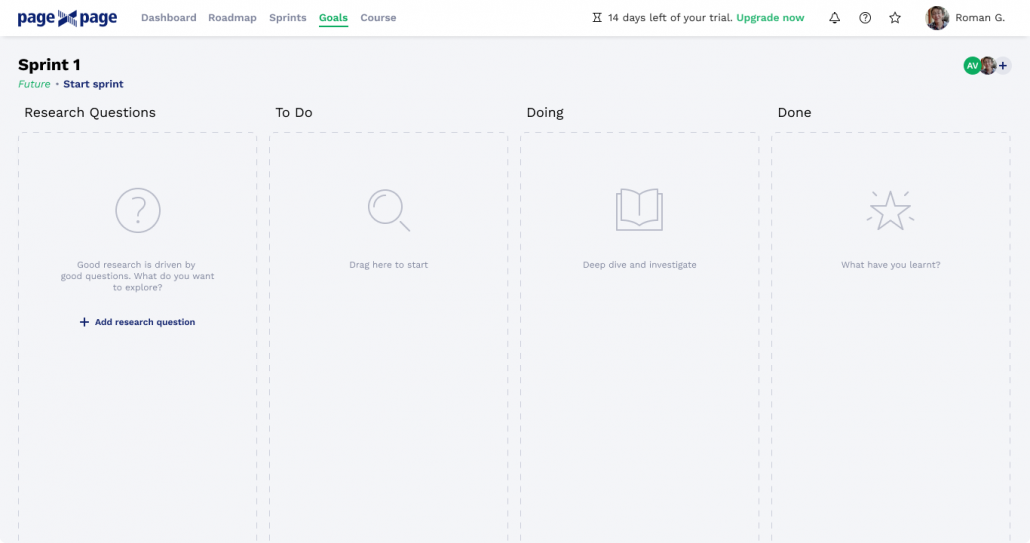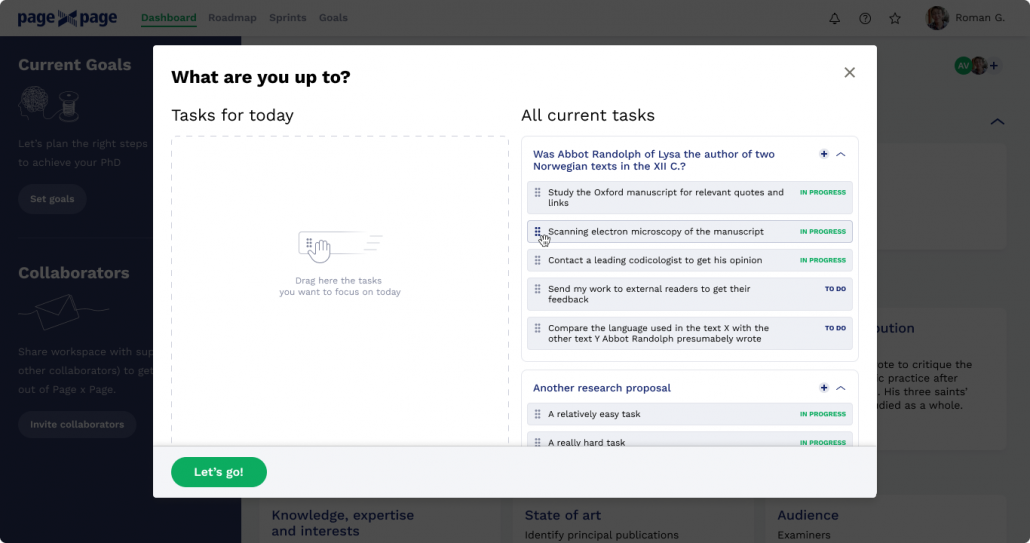A Better Way to Do Research? Applying Design Thinking and Lean Principles to Writing Your PhD Thesis
Research and PhD thesis writing are by their nature unpredictable.
Given that research is the systematic investigation into and study of materials and sources in order to establish facts and reach new conclusions this is to be expected.
Many students struggle with the complexities and uncertainties inherent in the research process leading to stress, overwhelm, and frustration at lack of progress.
Page x Page provides a solution to this common problem.
Adapting Design Thinking and Lean Startup principles and methodologies to academic research, Page x Page provides a roadmap and framework to assist students achieve their research goals faster and more efficiently saving them time, effort, and needless distress so that they can produce their best work on time and to a high standard. Goodbye to 8+ years of PhD agony or 50%+ drop out rates! We believe that if you are good enough to get accepted into a PhD program, you are good enough to finish it given the right support and mentoring.
Every research project whether it is a PhD project or other can be broken into four key stages. Through each stage regular feedback and guidance can be provided by the student’s supervisor(s), peers, or research coach.
Let’s take a more detailed dive into the Page x Page framework with each stage of the research journey explained:
1. Incubation/ Ideation
The first stage in any research project is the Incubation or Ideation stage. This involves immersion and deep knowledge in your field through completing a set course of postgraduate studies, reading, attending research seminars, discussion with peers and thought leaders, and studying the latest developments in your field.
A baseline level of familiarity first needs to be established from which new insights and ideas can emerge. You can’t have insights about things you don’t know anything about. This can only emerge from domain knowledge.
In the book The Creative Curve, Allen Gannett recommends spending 20% of your time each day on consuming and establishing prior knowledge out of which immersion will emerge the right questions and insights that will shape your research project. Capturing tools like Evernote or a pocket notebook or journal as well as research reference software like Zotero are recommended to keep track of ideas, insights, and relevant literature. The focus of this stage should be identifying 1 to 3 research topics that would merit further investigation. As a guideline to identifying promising research areas, these topics should be:
1). Feasible – able to be completed during the determined timeframe of the research project
2). Interesting – able to sustain your interest over the duration of the research project
3). Valuable – able to contribute original knowledge in your field and drive the research area forward
Research impact is largely outside the influence of the researcher and is a product of the execution and dissemination of results from a successful research project. It relates to how others adopt your research ideas.
As the book The Usefulness of Useless Knowledge by Abraham Flexner reminds us, it is often impossible to know in advance the impact and application that our research will have. He advocated that research should largely be unhindered by utilitarian concerns and driven by unhampered curiosity. As the man who hired Albert Einstein and who was behind the establishment of the Institute for Advanced Study in Princeton, Flexner’s advice is worth bearing in mind whenever there is an overemphasis on research impact.
Because this Ideation stage will vary from researcher to researcher, Page x Page does not address this stage in the research process as it assumes sufficient domain expertise and instruction in your chosen field. The focus instead will be on the planning, execution, and presentation of the research results through tools that guide the researcher through these distinct stages.
2. Planning and Parameters
The second stage is planning and establishing the parameters of your research project. The constraints and limits of the research project need to be established from the beginning in order to encourage focused research. As the research progresses this can be reframed and reset on the basis of new data, but having clearly defined research avenues should be determined from the start.
The PhD Model or Research Canvas tool provides a one-page overview of the research project by breaking it down into its key components or elements. This helps the researcher get an overview of the research project while systematically thinking through each component of their research project.

Multiple versions of the Research Canvas can be quickly created to capture different research proposals before settling on one version to pursue. A record of your Research Canvases are kept so that you can see how your research iterations have developed and progressed from the start of your research project. You no longer need to spend time and energy on writing a lengthy Research Proposal, though a more detailed plan can and should be developed once a promising research topic has been chosen.
The Research Canvas also helps to clarify the riskiest areas in the research project so that the researcher can tackle these issues first. Questions relating to research topic/supervisor fit, securing sources of funding, research gap and state of art in the field (i.e. what’s already been done), relevance and potential significance of the research project can be tackled at this stage.
The research project will fail if these elements are not addressed and thought through from the start. Feedback can be quickly solicited and given by sharing the Research Canvas with the supervisor(s) and other collaborators.
Research projects fail through not choosing and working with the right people or team (especially important here is the supervisor), not having access to resources and funding, choosing a topic that cannot sustain your longterm interest, choosing a too broad or unfeasible topic where a research gap has not been sufficiently identified, and through poor time, project, and personal wellbeing management.
Systemic cultural issues in academia can also play a role in having an adverse impact on productivity and researcher welfare – issues that are best left to brave organisational intrapreneurs and change agents to resolve to the extent that they are able to do so within their respective institutions.
The Research Canvas begins with the End in Mind by prompting the researcher to envision the outcome that she or he is looking to create by the end of the research project. This helps the researcher to think in terms of specific outcomes and to clarify Why this research project is important to them. Having a clear vision and how this relates to their career goals will help sustain motivation and commitment.
Research projects are unsustainable longterm unless they spring from the intrinsic interests and innate curiosity of the researcher. They need to be self-chosen and self-directed so that the researcher’s sense of autonomy, mastery, and purpose can be honed. Knowledge, Expertise, and Interests help clarify the ground from which the research project will come through honing in on existing domain expertise and interests. General subjects or topics can be noted here.
Research results need to be disseminated through various Channels whether they are published research papers, the PhD dissertation, books, podcasts, or blogs. Channels prompts the researcher to think about the medium/ media through which their research findings will be shared with their peers.
Having the right supervisor(s) and working with the right people are critical to the successful completion of any research project, while having a support network is key for researcher welfare and mental health. The names of Key Partners can be listed here, people you can rely on and who have your back. They will be your Cheerleaders as you progress.
While Channels dictate the media through which your research is disseminated, who are you writing for? Who is your end user? It may not be solely other academics, but could include thought leaders in government, industry, or NGOs. This will influence the Channels you choose to publish in. Audience will include examiners, other researchers in your field, but also think about other groups that would be interested in your research. This helps to think about your Audience in advance.
Research does not happen in a vacuum, but is built upon an existing body of knowledge. What has already been done in your research area/topic, what’s the State of Art? Try to put down here the principal key works or names of authors that will guide you in your literature review of principal publications.
Good research stems from good research questions. It’s easier to do focused research if you are guided by 2 or 3 specific research questions.
Lead with questions.
Choose 2 or 3 research questions that will drive and steer your research so that it is as focused and targeted as possible. These questions can and will change as your research advances.
Key Activities help keep front and centre those core activities that the researcher will focus on on a day to day basis. These will vary by discipline but could include running experiments, sourcing materials, reading and note taking, writing, bibliographic search, networking with other scholars etc.
Key Metrics are means by which the researcher measures their own progress by choosing one or two key metrics that they can keep track of. A key metric might be to write 500 words a day, read three articles, or measure tasks using the productivity technique of the Pomodoro method that helps to build flow while single-tasking. Page x Page integrates the Pomodoro method in measuring time spent on tasks. One Pomodoro time block = 25 minutes of concentrated focus on a single, uninterrupted task. So one metric might be to commit to doing 8 Pomodoro blocks a day on research tasks.
The PhD is awarded for making a significant original contribution to knowledge and original research is geared towards the creation of new knowledge. The centre of the Research Canvas concerns this core contribution. Capturing what you think this is (it may change as your research progresses) in your thesis statement helps clarify the core value proposition of your research project.
The Twitter Thesis is how you explain this to a non-expert in a clear and concise way in less than 140 characters. It’s what you tell your Granny when she asks you what your research project is about. It also helps you to be crystal clear on what exactly you are working on.
Revenue Stream allows you to capture the exact numbers and sources of funding that will finance the research project as without sufficient funding research projects flounder.
What will your PhD cost you in terms of time, university fees, accommodation, and living expenses? Cost Structure helps you to gauge whether the overall commitment in terms of time, money, emotional investment, and opportunity costs are worth it. Capture specific numbers. Both Revenue Stream and Cost Structure need to balance out and be assessed ideally prior to embarking on the research project. The practicalities of research funding and time commitments need to taken into consideration at this stage before jumping headlong into the work.
The Research Canvas is envisaged as a framework tool or trellis that can systematically guide the researcher through the various components that constitute the building blocks of a successful research project.
It takes less than 20 minutes to complete, reduces time and waste spent on more detailed research proposals, and can be quickly shared with the supervisor(s) and other collaborators to get feedback on and sign off before further work.
The Research Roadmap provides a visual timeline with key milestones for the completion of the project that is automatically updated as the research project advances and can be modified by the researcher.

This provides both the researcher and the supervisor with a way of assessing progress and where they are on the research journey so that any issues can be dealt with in time and can be course corrected. The researcher can choose between thesis length, chapters or research papers and set timeframes that can be adapted.
3. Execution
The third stage is the execution phase where the principal research work is conducted. This is where the avenues of inquiry and the key research questions established in the second stage are investigated leading to new data and learning outcomes that informs the continuing research process.
Guided by the key research questions established in the Research Canvas, the researcher determines the next steps in the Goals feature as well as identifying potential obstacles or risks to their completion within a three-month timeframe (90 days).

Goals can be broken down into Objectives and Key Results. For example, my Objective might be to write 6,000 words for my literature review. Key Results might be to narrow down my research topic, determine a promising research gap to explore further, or provide a better overview of the field. To give another example, my objective might be to publish my first research paper of 8,000 words in a peer-reviewed journal.
A Key Result would be that it passes the peer review process and is accepted for publication.
These larger Goals are in turn broken down into more manageable concrete tasks that are implemented through a Kanban Board feature in Research Sprints, 2 to 4-week sprints focused on deep dives into the research questions and on advancing learning outcomes.
Research Sprints facilitate the speed at which the researcher progresses through the Knowledge Loop of:

driving the research project forward.

Research Sprints are time bound (usually 2 to 4 weeks in length) focused research periods where the researcher determines specific research questions and topics to investigate that will advance their research project forward leading to new learning outcomes and results by the end of the selected timeframe that will in turn inform the next set of questions and research tasks to explore.
They are systematic deep dives into the research subject area that encourage reflective practice and focused learning.
By progressing through the series of project management stages on the Kanban Board feature, the researcher builds small daily wins helping to maintain momentum and productive flow while deepening their knowledge of their field leading to new insights and learning that will inform their research results.
Here are the steps to take in setting up a productive Research Sprint:
1. Use the Research Questions box on the Research Canvas to determine the key questions to investigate and the Goals feature to determine immediate next steps
2. Pick the problems to be solved and the target research topic(s) to explore over the next 2 to 4 week timeframe
3. Narrow down potential research questions, research tasks/ experiments to work on during this timeframe
4. Systematically execute research tasks to produce research outcomes and data to get feedback from supervisor and peers by the end of the period
5. Based on learning outcomes, determine next research topic/ research questions to explore. Rinse and Repeat.
Research Sprints in turn inform the day-to-day tasks of the researcher helping them to stay focused while building flow and proven productivity habits into their workflow practices.

Through a systematised process of constant learning and feedback at the right time which in turns informs the right action, the researcher is led to the fourth and final stage:
4. Presentation
The presentation of their research results either through publication or through examination.
The results are subjected to a peer-review process leading to further revisions or to the successful completion of the research project.
At each step of the research journey Page x Page provides a proven process-driven system for achieving research results while providing touch points for the supervisor and other mentors to easily guide the research path of their students.
Page x Page empowers scholars to achieve their research goals faster and more efficiently while advancing the future of science and innovation.
To sign up for the PhD App which will assist in PhD thesis writing, register Here


 Instagram
Instagram